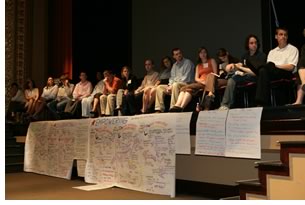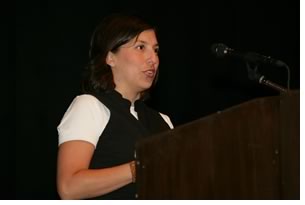

10/2005
 by
Suzanna Wight, AIA
by
Suzanna Wight, AIA
Emerging Professionals Director
Leaders from each of the five U.S. architecture collateral organizations—The AIA, American Institute of Architecture Students (AIAS), Association of Collegiate Schools of Architecture (ACSA), National Architectural Accrediting Board (NAAB), and National Council of Architectural Registration Boards (NCARB)—along with selected stakeholders and emerging professionals convened for the “Designing Tomorrow’s Architect: 2005 Internship Conference” to advance work to improve architecture internship. Ken Schwartz, FAIA, guided discussion for the three-day conference, which took place September 23–25 in San Antonio.
“We believe this conference is one step on a path that started perhaps more than a century ago and will move and continue into the future for as long as the profession exists,” said AIA President Douglas L Steidl, FAIA. For its part, the AIA will:
- Advocate for its recent position on ARE Timing, toward a planned vote by state boards at NCARB’s 2007 annual meeting
- Lead development of a Practice Academy and Teaching Firm models
- Call for another conference to continue this discussion in a formal manner.
 Building on precedent
Building on precedent
The objective of the 2005 Internship Conference, developing solutions
for improving architecture internship, furthered the goals of the first
two conferences: the first in April 1999 and the second in October
2002. “It was important that the participants understand what
was covered at the 1999 and 2002 Internship Summits so that their work
could build on those gatherings,” said Ana Guerra, Assoc. AIA,
the AIA’s conference co-chair. “Indeed, proposals from
the groups took past actions into consideration, but were forward thinking
and solution-based, providing a clear direction for the collaterals
to take forward, both collectively and individually.”
Major outcomes
This year’s participants worked together in diverse groups to generate
proposals for change. In the final session, proposals were synthesized
into four areas.
- Recommendations to collaterals: Proposals included adopting a dynamic internship model that allows for three varying paths to licensure: traditional (seat-time), competency-based, and individual (self-directed) plans. Other recommendations were to provide training for mentors and offer a provisional license earlier in the registration process (similar to the medical training model).
- Action proposals: These included charges for AIA Government Advocacy to seek alternative funding sources for internship support in the federal government, the AIA and ACSA to develop practice academy and teaching firm models, and for NCARB to host to an intern validation conference in 2007.
- Challenges: It was noted that competency-based internship extends beyond the current model of Intern Development Program (IDP), which is based on prescriptive number of hours. Others voiced concerns about lack of respect for architecture interns, compared to medical interns. There also was concern about differing definitions of what “success might look like” following the conference. (It was also noted that the conference participants did not define any intern responsibilities for change.)
- Visions: Visions included a potential redefinition of the title “architect” and the job description defined by practice acts; raising the bar for internships to improve respect, trust, and accountability for interns; and redefinition of the term “welfare” in “health, safety, and welfare,” to result in an expansion of architect influence on the community.
 Emerging professionals speak out
Emerging professionals speak out
The emerging professionals met informally during the weekend to outline
specific recommendations for action on internship. Along with the recommendations,
the group stressed that:
- Interns should be able to take the exam upon graduation and concurrent with internship
- IDP should be expanded to allow alternative paths for obtaining professional experience
- NCARB should allow mentors to be the key figure in the IDP process (not only the direct supervisor)
- An advocacy group should be formed to focus on the Architect Registration Examination (ARE)
- Mentorship should be a requirement for completion of IDP
- A percentage of continuing education learning units should be required to be obtained through mentoring interns
- The advancement of IDP should include a validation conference, and state boards must be a part of that conference.
 “The
emerging professionals were the stars. They drove the conference and
their opinions, thoughts, and creativity were critical to the outcome,” commented
NCARB Past President Frank Guillot, AIA. For its part, NCARB plans to
request a rigorous, objective, and empirical analysis of the impacts
on health, safety, and welfare stemming from the proposed concurrent
internship and ARE model; report on concerns for more effective and responsive
supervision and mentoring; and continue to monitor the competency-based
internship model developed by California.
“The
emerging professionals were the stars. They drove the conference and
their opinions, thoughts, and creativity were critical to the outcome,” commented
NCARB Past President Frank Guillot, AIA. For its part, NCARB plans to
request a rigorous, objective, and empirical analysis of the impacts
on health, safety, and welfare stemming from the proposed concurrent
internship and ARE model; report on concerns for more effective and responsive
supervision and mentoring; and continue to monitor the competency-based
internship model developed by California.
For more information and to read about the proposed actions by the other collaterals, visit the Emerging Professionals portion of the AIA Web site.
Copyright 2005 The American Institute of Architects.
All rights reserved. Home Page ![]()
![]()
 |
||
The conference Web site will be updated regularly with new information, including proceedings following the conference. In addition, the ACSA, AIAS, and AIA have committed to hosting follow-up workshops on selected topics at their upcoming annual meetings in 2005 and 2006.
|
||